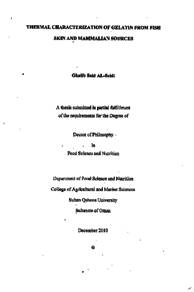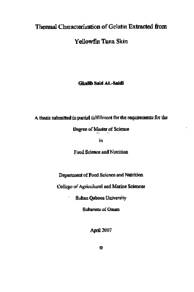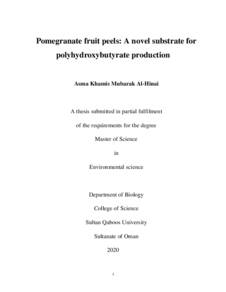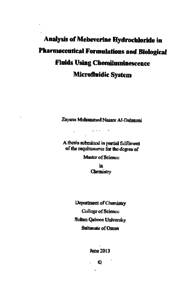Document
Thermal characterization of gelatin from fish skin and mammalian sources
Publisher
Sultan Qaboos University
Gregorian
2010
Language
English
Subject
English abstract
The present work dealt with the physic-chemical and thermal properties of commercial bovine and porcine gelatins and of shaari (Lethrinus microdon) fish skin gelatin extracted under different conditions (temperature and acetic acid concentration). In addition an innovative method that measures thermal relaxation characteristics was developed.
The state diagram of bovine gelatin was developed by measuring the freezing curve, glass transition, unfolding, solids-melting lines, and ultimate maximum freeze-concentration conditions. The freezing point decreased with the increase of solids; whereas glass transition, unfolding, and solids-melting decreased with the decrease of solids up to solids' content 0.84 kg/kg gelatin and then remained constant. The freezing point, glass transition and solids-melting were modeled by Chen's model based on the Clausius-Clapeyron equation, modified Gordon-Taylor model, and Flory's equation, respectively. The ultimate maximum-freeze-concentration conditions were found as (Tm')w equal to -11.9°C and (T8'"')# equal to -14.9°C, and the characteristic solids content, X, as 0.80 kg/kg sample (i.e. un-freezable water, X=0.20), respectively. Similarly the value of Tom (i.e. intersection of vertical line passing thru Tm' and glass transition line) was estimated as 34°C.
A new innovative method to measure the thermal-relaxation by maintaining isothermal condition in a Differential Scanning Calorimetry (DSC) was developed. The DSC thermal-relaxation characteristics of gelatin and date flesh were found to be related with the structural- and mechanical-glass transition measured by conventional DSC linear-heating and thermal-mechanical analysis (ie Differential Thermal
chanical Analysis, DMTA). Initial slope of the thermal relaxation curve (i.e., heat flow versus relaxation time) was determined and it was plotted as a function of relaxation temperature (i.e. isothermal condition). The initial slope-temperature graph showed three thermal relaxation characteristics: limited mobile, freely mobile and restricted mobile regions. The region 1 showed limited molecular mobility with increasing temperature, while region 2 showed free mobility with increasing temperature sensitivity. The intersection of the regions 1 and 2 was related to the
structural-glass transition measured by conventional linear-heating in a DSC. The region 3 showed restricted mobility due to enhanced interactions of the phases at higher temperature. This region 3 was related to the entangled flow region measured by thermal-mechanical analysis in a DMTA.
TIPI ICO Gelatin from shaari skin was extracted as a function of temperature and concentration of acetic acid. The concentration and temperature of extracted solutions were varied from 0.01 to 1.0 N and 4 to 80°C, respectively. Gelatin extraction yield increased with the increase of acetic acid concentration and temperature. Gelatin extracted from shaari skin using 0.1 N acid solutions and temperatures of 50 and 80°C gave highest protein content comparable to that of commercial bovine and porcine gelatins. Shaari gelatin contained higher amount of the amino acids alanine, glycine, and threonine; and lower contents of hydroxyproline, isoleucine and proline than bovine and porcine gelatins. The L values of bovine and porcine gelatins were significantly higher (p<0.05) (i.e. less dark) than those of shaari gelatins extracted under experimental conditions used in this study, In general, gelatin extracted from shaari gelatin showed lower onset of glass transition temperature than mammalian gelatins. For shaari skin gelatin, the onset of glass transition temperature decreased with the increase of extraction temperature up to 50°C and then remained nearly constant. The decrease in glass transition was more pronounced for gelatin extracted at 0.01 N compared to the 0.1 and 1.0 N samples. Unfolding temperature decreased exponentially with the increase of extraction temperature. The unfolding temperature shifted to lower temperature, and the decrease was more pronounced in the case of higher (1.0 N) concentrated samples. The extraction concentration and temperature did not show significant effect on the onset solids-melting temperature. Fourier Transform Infrared Analysis (FTIR) was used to characterize secondary structure of gelatins extracted from shaari skin and commercial bovine and porcine gelatin. The secondary structure of gelatin extracted using mild treatment (concentration: 0.01 N and temperature: 4°C) was observed completely different from other extracted gelatin. This study generated detailed thermal and molecular characteristics of gelatin from different sources.
Member of
Resource URL
Arabic abstract
في هذا البحث تمت دراسة الخواص الفيزيائية والكيميائية والحرارية للجيلاتين المستخلص من جلد الأبقار والخنازير ومقارنتها بخواص الجيلاتين المستخلص من جلد سمك الشعري تحت درجات حرارة وتراكيز الوسط الحمضي. وبالإضافة إلى ذلك تم تطوير طريقة مبتكرة لقياس خصائص الأسترخاء الحراري. وقد تم وضع مخطط الحالية (state diagram) للجيلاتين البقري عن طريق قياس منحنی التجميد (freezing curve) والحالة الزجاجية (glass transition) والانفتاح (unfolding) ومنحنی الانصهار ( solids - melting ) والنهاية القصوى لظروف تجميد. التركيز (-ultimate maximum freeze - concentration ). وقد لوحظ خلال الدراسة انخفاض درجات حرارة التجميد مع زيادة المواد الصلبة، في حين انخفضت درجات حرارة الحالة الزجاجية والانفتاح والانصهار مع انخفاض المواد الصلبة حتى مستوى 0 . 84 جرام / جرام للجيلاتين ثم ظلت ثابتة تم نمذجة درجات حرارة التجميد والحالة الزجاجية والانصهار باستخدام معادلة (Chen) المعدلة من معادلة Clausius - Clapeyron المشتقة من معادلتي Gordon - Taylor و Flory علي التوالي. وقد أوضحت النتائج أن النهاية القصوى لظروف تجميد التركيز ('T) وجدت تساوي 11 . 9 - درجة مئوية و (T) تساوي 14 . 9 درجة مئوية وخواص المادة الصلبة (X) تساوي 0 . 80 جرام/جرام والماء غير القابل للتجميده ( 0 . 20=x) على التوالي. و بالمثل قدرت قيمة ("T) عن طريق نقطة تقاطع الخط العمودي المار ب ('T) ومنحنى الحالة الزجاجية ب 34 درجة مئوية وقد تم استخدام طريقة مبتكرة تم تطويرها لقياس خصائص الاسترخاء الحراري باستخدام جهاز (Differential Calorimetry ( DSC Scanning ، و قد أوضحت الدراسة أن خواص الاسترخاء الحراري المقاسة باستخدام جهاز DSC للجيلانين والتمر لها علاقة بالحالة الزجاجية الميكانيكية والتجسيمية المقاسة بالتسخين الخطيب-DSC والتحليل الميكانيكي الحراري المقام بجهاز (Differential Thermal Mechanical Analysis DMTA). تم تحديد بداية الانحدار في منحنی الاسترخاء الحراري (تدفق الحرارة في مقابل رقت الاسترخاء) واستخدامه في رسم منحني الاسترخاء الحراري. واظهر الرسم البياني لمنحنی بداية الانحدار ثلاث خصائص للاسترخاء الحرارية الحركة المحدودة والحركة الحرة والحركة المقيدة. واظهرت المنطقة الأولى التنقل المحدود الجزيئي مع زيادة درجة الحرارة بينما أظهرت المنطقة الثانية التنقل الحر مع زيادة حساسية درجة الحرارة. وقد أظهر ان نقطة التقاء المنطقة الأولى بالمنطقة الثانية لها علاقة بالحالة الزجاجية الهيكلية المقاسة بالتسخين الحراري ہDSC. واظهرت المنطقة الثالثة حركة مقيدة بسبب تعزيز التفاعلات بين المراحل المختلفة مع ارتفاع درجة الحرارة. وهذه المرحلة لها علاقة بمنطقة التشابك في التدفق المقاس با DMTA تم استخراج الجيلاتين من جلد سمك الشعري في ظروف مختلفة من درجات الحرارة وتركيز حمض الخليك زادت نسبة الجيلاتين المستخلص مع زيادة تركيز حمض الخليك وارتفاع درجة الحرارة. اعطى الجيلاتين المستخرج من جلد سمك الشعري باستخدام محلول حامضي بنسبة 0. 1N ودرجات الحرارة 50 و 80 درجة مئوية أعلى محتوى للبروتين مقارنة بالجيلاتين التجاري. يحتوي جيلاتين جلد سمك الشعري على نسبة اكبر من الأحماض الأمينية الألانين (alanine) والجلايسين (glycine) والثيروئین (threonine) ونسبة اقل من الأحماض الأمينية مثل الهيدروكسيبرولین (hydroxyproline) والأيسولويسين (isoleucine) والبرولین (proline) مقارنة بجيلاتين الأبقار والخنازير. وبالنسبة للون الجيلاتين المستخرج فقد كانت قيمة L أعلى لجيلاتين الأبقار والخنازير (اي اقل ظلمة)( 0 . 05>p) منها للجيلاتين المستخرج من جلد سمك الشعري في هذه الدراسة. وبصورة عامة كانت درجة حرارة الحالة الزجاجية الجيلاتين جلد سمك الشعري اقل من تلك في الجيلاتين الحيواني، وقد انخفضت درجة حرارة الحالة الزجاجية مع ارتفاع درجة حرارة الاستخلاص حتى وصلت إلى 50 درجة مئوية حيث ظلت ثابتة تقريبا كما كان انخفاض درجة حرارة الحالة الزجاجية أكثر وضوحا لعينات الجيلاتين المستخرج بتركيز 0 . 01N من الجيلاتين المستخرج بتركيز N 0 . 1 و 0N,, انخفضت درجة حرارة الانفتاح بشكل كبير ايضا مع ارتفاع درجة حرارة الاستخلاص. وانخفضت درجة حرارة الانبساط الى درجات حرارة اقل وكان الانخفاض أكثر وضوحا العينات الجيلاتين المستخلصة بواسطة حامض بتركيز 1 . 0N. لم تظهر درجة الحرارة وتركيز حامض الاستخلاص أي تأثير على درجة حرارة الانصهار. وجد ان جيلاتين جلد سمك الشعر المستخلص في وسط حامضي بتركيز N 0 . 01 ودرجة حرارة 4 درجة مئوية مختلف تماما عن بقية العينات عندما استخدم جهاز تحليل الأشعة تحت الحمراء (Fourier Transform Infrared Analysis)FTIR لدراسة الهيكل الثانوي للجيلاتين من جلد سمك الشعري المستخلص بدرجات حرارة من 4 الى 80 درجة مئوية وتراكيز وسط حامضي N 0 . 01 و 0 . 1N و 1, 0N ومقارنتها بالجيلاتين التجاري. أوضحت هذه الدراسة تفاصيل دقيقة عن الخواص الحرارية والجزيئية للجيلاتين من المصادر المختلفة.
Category
Theses and Dissertations




